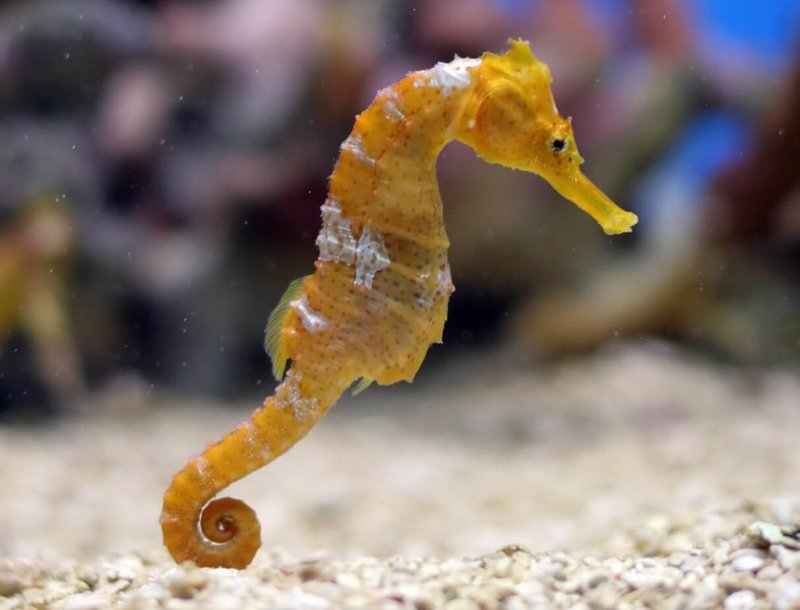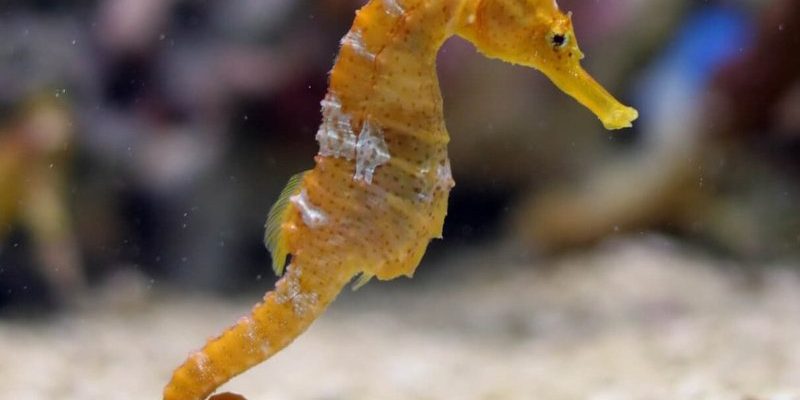
Seahorses are some of the most intriguing creatures in our oceans. With their unique shape, delicate fins, and charming personalities, they seem almost like something out of a fairy tale. Imagine a tiny horse with a curled tail, floating gracefully among corals and sea grasses. It’s easy to see why they capture our imagination!
These little fish are not only fascinating to look at; they have some remarkable traits that set them apart from other marine animals. For example, did you know that male seahorses are the ones that carry and nurture the babies? This inversion of traditional roles offers a glimpse into the wonders of nature and the diversity of marine life.
In this article, we’ll dive deeper into the world of seahorses, exploring their habitat, diet, physical characteristics, reproduction, and conservation efforts. You’ll walk away with a better appreciation for these enchanting sea dwellers!
Physical Characteristics of Seahorses
Seahorses have a truly distinct appearance. Their bodies are covered in bony plates instead of scales, giving them a unique texture. They lack the traditional fish attributes, like fins that are well-suited for fast swimming. Instead, seahorses have small dorsal fins that flutter rapidly, allowing them to steer through the water while they cling to seaweed and corals using their curled tails.
One of the most captivating features of seahorses is their head, which resembles that of a horse—hence the name. Their long snouts are perfect for sucking in small prey, like tiny shrimp and plankton. Interestingly enough, seahorses also have the ability to change color, allowing them to blend in with their surroundings. This adaptability helps them avoid predators and can be a fascinating topic when discussing camouflage in the animal kingdom.
On average, seahorses range in size from about 1 inch to just over 12 inches. The smallest species, the pygmy seahorse, is so tiny that it can easily hide among coral. The larger species, like the common seahorse, can be found swimming gracefully in shallower waters, making them easier to observe for curious snorkelers and divers alike.
Habitat of Seahorses
Seahorses are found in a variety of marine environments, primarily in shallow coastal waters. They love to hang out in seagrass beds, coral reefs, and mangrove forests. These habitats provide not just food but also places for seahorses to anchor themselves with their prehensile tails. It’s like having your own little home where you can relax and enjoy the scenery!
You might be wondering why seahorses prefer these specific areas. The seagrasses and corals offer protection from larger predators and provide access to food sources. Seahorses are masters of disguise, and their ability to blend into their environment makes it easier for them to avoid becoming a meal for fish or birds.
Interestingly, seahorses are not the best swimmers. They are relatively slow and prefer to stay close to the bottom of the ocean, where there is plenty of coverage. This is why their habitats are often rich with plant life. They can latch onto a blade of grass or coral, using it as a perch while they wait to catch their next meal.
Diet and Feeding Habits
Seahorses are carnivorous and primarily feed on small crustaceans, including shrimp and tiny fish. Imagine using a straw to sip your drink—that’s how seahorses eat! Their elongated snouts act like a vacuum, sucking in food as they hover in place. This feeding style is quite efficient for their small size, allowing them to consume up to about 30-50 meals each day.
One interesting aspect of a seahorse’s diet is that they don’t have stomachs. Instead, food passes through their bodies quickly, which means they need to eat often. They are also quite picky eaters; if the water is polluted or food is scarce, they may struggle to find enough to eat. This makes them sensitive to changes in their environment, further emphasizing the need to protect their habitats.
Since seahorses can’t swim against strong currents, they rely on their camouflage to ambush their prey. They often stay very still, mimicking the movement of plants or algae. When a small shrimp or plankton comes close enough, they strike quickly. It’s a clever and effective tactic that ensures they get enough nourishment to thrive in their underwater world.
Reproduction and Life Cycle
Seahorse reproduction is truly one of nature’s wonders. Unlike most animals, it’s the male seahorse that becomes pregnant. The female deposits her eggs into a special pouch located on the male’s belly, where he fertilizes them. It’s like the male has his own little incubator! This pouch provides a safe environment for the developing embryos, ensuring that they are protected until they’re ready to be born.
After a gestation period that can last anywhere from 10 days to six weeks, the male seahorse gives birth to tiny, fully formed babies. Each male can release anywhere from 5 to over 1,000 baby seahorses at once, depending on the species and conditions. These little ones are miniature versions of adults and will soon venture out into the big ocean.
An interesting note is that seahorse offspring are independent from the moment they are born. They don’t receive further parental care, which is quite different from many other species. This means the survival rate can be low, with many young seahorses becoming prey for various predators. This cycle of life is as beautiful as it is harsh, and it plays an essential role in the overall ecosystem of marine life.
Conservation and Threats
Despite their enchanting nature, seahorses face numerous threats in the wild. Habitat destruction, primarily from coastal development and pollution, poses significant risks to their populations. As their homes disappear, so do their chances of survival. Additionally, seahorses are often caught unintentionally in fishing nets, leading to accidental deaths.
Another major threat to seahorses is the illegal trade for traditional medicine and aquariums. Many cultures believe seahorses have healing properties, which has led to overfishing in some regions. This demand can be detrimental to their populations, disrupting the balance of marine ecosystems.
Conservation efforts are underway to protect seahorse habitats and raise awareness about their plight. Organizations work diligently to create marine protected areas where seahorses can thrive, free from human interference. Supporting these efforts is crucial for ensuring future generations can enjoy the wonders of seahorses in the wild.
| Attribute | Details |
| Size | 1 to 12 inches |
| Habitat | Shallow coastal waters, seagrass beds, coral reefs |
| Diet | Small crustaceans, plankton |
| Reproduction | Male carries fertilized eggs in a brood pouch |
| Lifespan | 3 to 5 years in the wild |
| Color Change | Can change colors for camouflage |
| Unique Trait | Male pregnancy |
FAQ
What do seahorses eat?
Seahorses feed primarily on small crustaceans such as shrimp and tiny fish. They use their elongated snouts to suck in food, much like a straw. This feeding method allows them to consume several meals a day, vital for their survival as they lack stomachs and digest food quickly.
How do seahorses reproduce?
The reproduction process of seahorses is quite unique. The female deposits her eggs into the male’s brood pouch, where he fertilizes them. The male then carries the eggs until they hatch, giving birth to tiny, fully-formed juvenile seahorses. This role reversal in parenting is a fascinating aspect of their biology.
Where do seahorses live?
Seahorses inhabit shallow coastal waters, often found among seagrass beds, coral reefs, and mangrove forests. These environments provide crucial shelter and food sources, allowing seahorses to thrive and escape from predators. Their preference for these habitats is vital for their survival.
How long do seahorses live?
In the wild, seahorses typically live for about 3 to 5 years. However, their lifespan can vary based on environmental factors and threats they face, such as predation and habitat loss. Conservation efforts aim to maintain healthy populations to support their longevity.
Are seahorses endangered?
Several species of seahorses are threatened due to habitat destruction, pollution, and overfishing for traditional medicine and aquariums. Conservation initiatives are crucial to preserving their habitats and ensuring their survival in the wild.
Can seahorses change color?
Yes, seahorses can change color, which helps them blend into their environment for camouflage. This ability serves as a protective mechanism against predators, allowing them to hide among corals and seaweed. Color changes can also reflect their mood and health.
Do seahorses have predators?
Yes, seahorses have several natural predators, including larger fish, birds, and other marine animals. Their ability to camouflage themselves helps them evade these threats, but their slow swimming speed makes them vulnerable. This emphasizes the importance of their protective habitats.
How can we help protect seahorses?
Supporting conservation efforts, reducing plastic waste, and advocating for marine protected areas are effective ways to help protect seahorses. You can also raise awareness about the threats they face and avoid purchasing products made from seahorses or their habitats. Every action counts in preserving these amazing creatures.
What is the largest species of seahorse?
The largest species of seahorse is the hippocampus abdominalis, commonly known as the big-belly seahorse. It can grow up to 14 inches long. This impressive size makes it a unique representative of its kind, and its conservation is vital to maintaining biodiversity within marine ecosystems.
Do seahorses have good eyesight?
Seahorses have excellent eyesight, which helps them spot prey and avoid predators. Their eyes can move independently, giving them a broader field of vision. This adaptation is crucial, considering their slow movement and reliance on camouflage for protection.
What role do seahorses play in the ecosystem?
Seahorses play an essential role in their ecosystems as both predators and prey. They help control populations of small crustaceans, which can become overabundant if not kept in check. Additionally, as a food source for various predators, they contribute to the food web, supporting overall marine biodiversity.

